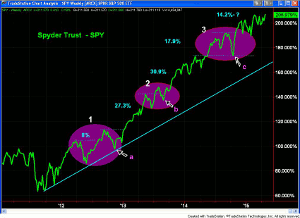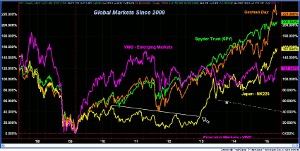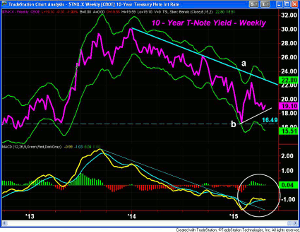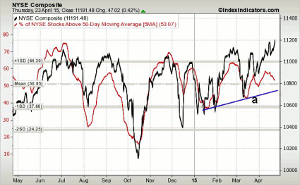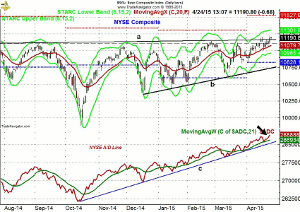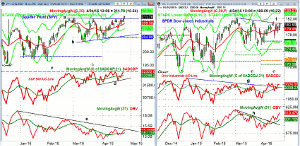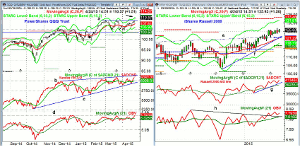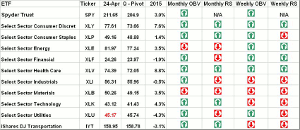If the level of bullishness is now low enough to fuel a substantial stock market rally, what happens next? MoneyShow's Tom Aspray takes to the % Change chart for a technical review of what happened after other breakouts in previous years.
In last week’s Fakeout or Breakout? I made the case based on the technical evidence that “despite Friday’s drop, I expect last week’s highs in the major averages to be surpassed in the coming weeks.” As you may recall, the S&P 500 was down over 1% on Friday April 17 and the bearish sentiment spiked.
In last Thursday’s trading, the NYSE Composite, Nasdaq 100, Nasadaq Composite, and S&P 500 all broke out to new multi-year highs. The small-cap Russell 2000 had already made new all time highs on April 15. The Dow Industrials are still below the March high of 18,188.
The Nasdaq Composite got the majority of attention as it ended Thursday above the March 10, 2000 closing high. While some think this is just another reason the market must be making a major top, many experts have concluded that the Composite is a much different market now than it was in 2000.
The widespread dismal outlook for earnings has kept many investors on the sidelines and a large number of analysts were not expecting anything to happen to stocks in the next few months. The bullish %—according to AAII—had dropped to a low of 27.16% on March 19 and was at 31.47% last Thursday.
This is not the extremely low level of bullishness that was recorded at the 2010 and 2011 lows when it was close to 20%. Still, I think it is low enough to fuel a substantial stock market rally. In addition, there is quite a bit of evidence that the public is still generally not invested in stocks, despite the incredible bull market since the March 2009 lows.
Markets probably need to close 0.5% above last week’s lows to really convince the skeptics that the breakout is real. But if that occurs, what is next?
The % Change chart of the Spyder Trust (SPY) reviews what happened after some of the recent breakouts. In 2012, once the March highs were overcome (Area 1), the SPY rallied 8% before dropping 17% into the 2011 low (point 1).
The breakout above the September 2012 high came in early 2013 as SPY rallied 27.3% into the May 2013 high. The SPY corrected for nine weeks before a brief push of 5% above the May high (Area 2). The following correction took SPY back into good support (point b) before the rally resumed.
By March 2014, the SPY had gained 30.9% before if corrected just over 10%. The next breakout (Area 3) took the SPY 17.9% higher by September 2014. The October correction (point c) took away a good part of these gains. By the end of October, the SPY had again broken out to new highs and it is currently up over 14% from the breakout level.
So, what does this mean for the market now? On a percentage basis just a 2% rally would not be surprising after this breakout. This could take the SPY up to the $216 area which would mean a 10% gain for the year. On the other hand, a 5% gain could take the SPY as high as the $221-$222 area.
It should also be noted that a breakout and sharp rally are often followed by rather significant corrections back to good support. The analysis of the A/D line as the rally progresses should help us determine the most likely rally scenario and allow us to sidestep future corrections as it has in the past.
The global markets have outpaced the US markets so far this year, but since the market lows in 2009, the disparity has not been as great. The German Dax Index is up 221.3%, which is only 15% more than the 206.4% gain in the SPY.
Japan’s NK225 has surged recently and is trying to catch up as it is now up just over 157%. It did very little for the first four years of the bull market as it broke through resistance, line a, in early 213 (see arrow).
The Vanguard FTSE Emerging Markets (VWO) has done well in 2015 but is still the laggard as it is up just over 121%. It is still below the peak from last September when it was up over 131%.
NEXT PAGE: What to Watch
|pagebreak|Of course, this week, the focus will again be on what the Fed will or will not do on rates. The consensus now is for a rate hike in September but that could easily shift to December if some of the economic data remains soft. As I have mentioned many times in the past, the FOMC meeting is no reason to change your investment plan.
The yield on the 10- Year T-Note is trying to turn higher, line b. The long-term downtrend, line a, is now in the 2.26% area, which also corresponds to the March high in yields. The starc+ band is a bit higher at 2.282%. The MACD also now shows a potential bottom formation (see circle), but a further rise in yields is needed to complete the bottom formation.
Last week’s data on the housing market did not help clear up any confusion over the economy. The Existing Home Sales surged over 6% in March which was the highest reading since September 2013. This increased the positive expectations for the March New Home Sales the following day. Instead, they dropped 11.4% as the biggest decline came in the South. Next week’s S&P Case Shiller HPI and Pending Home Sales should shed further light on the housing market.
The economic calendar is full this week with Monday’s Dallas Fed Manufacturing Survey as well as flash reading on the PMI Services Index. On Tuesday, we get the S&P Case-Shiller HPI, Consumer Confidence, and the start of the FOMC meeting.
Wednesday will likely get the most attention as we have the advance reading on 1st quarter GDP, the Pending Home Sales Index, and then the afternoon FOMC announcement.
On Thursday, in addition to the jobless claims, we get the Employment Cost Index and the Chicago PMI. The PMI Manufacturing Index is out on Friday along with the ISM Manufacturing Index, Consumer Sentiment, and Construction Spending.
What to Watch
Over the last nine weeks, the bulls and bears have been fighting a seesaw battle.
The new weekly highs in the NSYE A/D line on March 20 have continued to favor an upward resolution of the trading range.
It has been clear that the volume has been low all year and the on-balance volume (OBV) has continued to lag prices. Both the daily and weekly OBVs are positive (above their WMAs) but most are still well below there previous peaks.
It is fairly uncommon for the A/D lines and OBV to diverge like they are now. There are many stocks where the weekly and daily OBV analysis is confirming the price action, unlike some of the widely traded ETFs. I have always relied on the A/D line analysis even when the OBV does not confirm.
Apple, Inc. (AAPL) closed the week higher and it is helping push both the PowerShares QQQ Trust (QQQ) and Sector Select SPDR Technology (XLK) higher. The stock was recommended last week (Time to Buy Apple Again?) as it appeared the correction was over. They report earnings after the close on Monday.
There are quite a few stocks with positive intermediate-term outlooks but many need to correct in order to provide good entry points The biotechnology stocks also appear to have turned completed their corrections (Has Biotech Turned the Corner?) but need a further rally to confirm.
When you get a price breakout, I look at the % of stocks above their 50-day WMA for all the major averages. It is one way to determine how much upside the market has. If the % is generally around the mean, then it can generally move to one standard deviation, or more, above the mean.
This week, I will look at the % of NYSE Composite stocks above their 50-day MAs. As of Thursday, the 5-day MA was flat at 53.1 just above the mean at 50.9%. The WMA is still in a short-term uptrend and could easily move up to the 70% level on a further rally.
By comparison, the 5-day MA is at 53.4% for the S&P 500, which is below the mean at 63.2%. A move to the 77-82% level would not be surprising.
The daily chart of the NYSE Composite shows the multiple closes above the resistance at line a. The width of the trading range (lines a and b) ranges from 400 to 1100 points depending on where you measure. This means measured targets from 11,500 to 12,200.
The daily starc+ band is at 11,527 with the quarterly projected pivot resistance at 11,527.
The rising 20-day EMA is now at 11,079 with the starc- band at 10,965. The quarterly pivot is at 10,828.
The daily NYSE Advance/Decline line made a convincing new high on April 15, which kept me in the bullish camp. Another new high was made last week after the A/D line tested its rising WMA.
NEXT PAGE: Stocks
|pagebreak|S&P 500
The Spyder Trust (SPY) looks ready to close the week well above the key resistance, at line a. In my analysis from the April 15 column, I concluded that:
- On an upside breakout, the 127.2% Fibonacci target is at $213.27.
- The monthly pivot resistance is at $214.64.
- The upside target from the trading range is in the $218-$220 area.
The daily starc- band is now at $213.79 while the 20-day EMA is now rising more sharply and is at $209.58. The daily starc- band is at $207.74 with additional support at $207 which was the April 17 low.
The S&P 500 A/D line made a new high on April 10, once Friday’s numbers are in, another new high is likely. The A/D line has initial support at its WMA with further at line d.
The daily OBV continues to lag the price action as it is below the long-term downtrend, line e. The weekly OBV (not shown) should close the week above its WMA.
Dow Industrials
The SPDR Dow Industrials (DIA) continues to lag the other major averages as it is up 2% versus a 5.9% gain in the PowerShares QQQ Trust (QQQ). The panic low of $177.16 on April 17 came quite close to the quarterly pivot at $176.58.
The short-term downtrend, line f, is still limiting the upside with further resistance at the last swing high of $181.63. The DIA needs a strong close above the March 2 high of $182.24 to make a new all time high.
The daily starc+ band is at $183.30 with monthly pivot resistance at $185.24.
The daily Dow Industrials A/D line is still holding above its downtrend, line g, but has not yet moved above the early April highs. The large-cap Dow stocks are bearing the brunt of the strong dollar’s drag on earnings.
The daily OBV broke through its downtrend, line h, on April 14 and has continued to make higher highs. Its WMA is rising more sharply, which is a positive sign. The weekly OBV (not shown) is above its WMA.
Nasdaq 100
The PowerShares QQQ Trust (QQQ) gapped to the upside on Friday closing near its daily starc+ band as positive earnings Thursday propelled many of the big tech names higher.
The breakout on the daily charts has been decisive with the quarterly projected pivot resistance at $114.67, a reasonable upside target. The weekly starc- band is just a bit lower at $114.16.
The 20-day EMA is at $107.61 and it has now turned up more sharply.
The daily Nasdaq 100 A/D dropped below its WMA a week ago and tested the uptrend, line c, before turning higher this week. It is above the early April highs but is still below the March highs. The A/D line has been forming higher highs, line b, for some time.
The OBV has just broken out above major resistance at line d. A further rally will confirm the breakout.
Russell 2000
The iShares Russell 2000 (IWM) has just been edging higher for the past few weeks and does not show the burst of upside momentum evident in the QQQs. Still the overall pattern is positive as the close above the resistance at line e, in February supported the bullish case.
The weekly starc- band is at $131.57 with the quarterly projected pivot resistance at $133.48.
There is initial weekly support in the $12.90 to $123.77 area with the rising 20-week EMA at $121.20.
The weekly Russell 2000 A/D looks ready to close the week at another new high. It continues to show a steep uptrend, line g, which is a sign of strength.
The weekly OBV made a new rally high two weeks ago and is now close to the high from the middle of 2014. The OBV is above its rising WMA.
NEXT PAGE: Sector Focus, Commodities, and Tom's Outlook
|pagebreak|Sector Focus
The lagging action of the iShares Dow Jones Transportation (IYT) continues to be the market’s Achilles heel. Though it did close the week higher, it is still solidly negative for the year. The monthly pivot resistance is at $162.64 and a strong close above the $165 level is needed to get it back in gear with the other major averages.
On Friday, it was able to close back above its quarterly pivot at $158.47. The rising 20-day EMA is now at $157.43.
The weekly technical studies remain negative while the daily OBV and relative performance analysis are positive.
Only four of the sector ETFs are now negative for the year, including the Select Sector Industrials (XLI), Select Sector Utilities (XLU), Select Sector Financials (XLF) and the iShares Dow Jones Transportation (IYT). The Industrials will close the week back above its quarterly pivot.
As has been the case for a few years, the Select Sector Health Care (XLV) continues to lead, now up 8.8% for the year, while the Select Sector Consumer Discretionary (XLY) has also added to its gains as it is now up 7.6%.
The Sector Select Technology (XLK) got a big boost last week and is now up 4.3% for the year. The Sector Energy (XLE) is holding firm as it is up 3.5%.
The defensive Select Sector Consumer Staples (XLP) did not do much last week and is up just 1.4% for the year.
Crude Oil
The market continues to act well as the weekly HPI is above zero for the first time since last August, which means the money flow is now positive.
Precious Metals
The SPDR Gold Trust (GLD) and Market Vectors Gold Miners (GDX) were both hit hard for the week. I reviewed the technical outlook for them and the iShares Silver Trust (SLV) last week in Bond King Likes Gold, Should You? The sharp drop on Friday confirms my technical outlook.
The Week Ahead
In last week’s column, I expected it to be an interesting week as I surmised that if the earnings continue to come in better than expected, those on the sidelines would be surprised.
Monday’s higher close started off the week on a good note as there was no follow through selling after the prior Friday’s sharp drop. By Tuesday’s close, there were signs that the drop was just a buying opportunity. The further strength by mid-week did favor a strong weekly close.
Most of the major averages did close Friday near the day’s highs, which typically would set a positive tone for early next week. The combination of Apple’s earnings and a full economic calendar could cause some volatility.
The choppy year and the wall of worry from the TV pundits have made buying stocks a tough sell. A further rally is likely to bring more money off the sidelines as many money managers can’t stay in their jobs through another year of underperforming the benchmarks.
On April 15, I outlined my strategy for taking some profits in the market tracking ETFs we have had all year. (Profit Taking Levels for SPY, IWM, and QQQ). This does not mean I will turn bearish if these levels are reached as it is a matter of money management.
For those who are not in the market and started a dollar cost averaging program last Monday as I suggested last time, stick with it. Make equal investments every two weeks until you have reached your pre-set limit.
The important decision for each of you is to determine your risk tolerance level and therefore what percentage of your portfolio you are willing to have in the stock market. That is really a personal decision that I cannot make for anyone else.
To keep up with my current market thoughts and new recommendations, follow me on Twitter.
Don't forget to read Tom's latest Trading Lesson, Four Tips for Buying the Dip.

